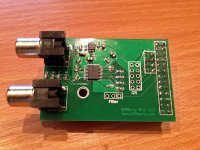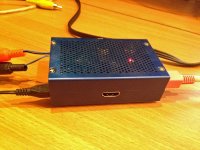@smallangryboy: There are 2 eval boards of the prototype, these are already reserved for 2 guys. There might be another 2 eval boards of version 2. The phono sockets will be parts of the kist, however, you do not have to solder them on the board.
@Turbon: This is not a USB DAC, it connects directly to the I2S port of the SoC.
Ok, rephrase - so we have a solution to get good sound outta the PI? I want one! Sign me up and let me see the bill!
Brgds
Any idea what the - 60 dB distortion is ? It seldom is better than 4% . I have been trying to devise a test for this . Perhaps record via an excellent CD burner like TEAC at - 60 db and use it for comparison tests . It should mean something to test the whole chain . An early Denon test disc was of a piano at 0 db - 20 dB and - 40 dB . Doubtless the disc as much as anything at fault . 0 db ( seldom used ) strong and clear . - 20 dB simlar but bleached out detail . - 40 dB like a Kazoo . Denon said construct an attenuator to test at identical levels . I did and didn't have to . From that I conclude pre 1990 CD had a real dynamic range of 20 db at best . Worse still is engineers were told not to go into the 0 to - 20 d range . To an extent dither added 20 dB to that ( 30 % THD became 3 % with dither ) . 4 % THD espeailly if not the higher harmonics at - 60 dB would be excellent . As someone recently said , analog recording fades to noise . Digital if dithered does also . If not one has to ask extra questions as noise is a full register of harmonics if white noise , 7 th and 9 th harmonics are not a great replacement no matter how small . One 24 bit chips maker said " no need for dither " . I wonder ?
Proof that - 20 db was typical is the input sensitive of tape deck inputs works fine with CD . In principle it is about 15 dB too high . Even knowing tape decks peak at + 6 dB doesn't account for it all . Build to the 2 v spec and CD will be too quiet . Not true of a pick up amp built with 6 dB spare gain . It is obviously loud .
Proof that - 20 db was typical is the input sensitive of tape deck inputs works fine with CD . In principle it is about 15 dB too high . Even knowing tape decks peak at + 6 dB doesn't account for it all . Build to the 2 v spec and CD will be too quiet . Not true of a pick up amp built with 6 dB spare gain . It is obviously loud .
Last edited:
That's great to know . I will do the chain one day as like vinyl one needs benchmarks . I said to a German guy . " Why do we insist on getting RIAA correct to 0.05 dB when the pick up might be + 7 dB 14 kHz " ? " We get right what we can " was his answer . It sounds right but is mathematical nonsense . The big picture often brings surprises . Doing the detailed study says sometimes why despite evidence one thing sounds different in a way where 0.05dB could not matter . Worse still if 0.03 dB becomes a quest . I get people tell me the NE 5532 is a rubbish op amp . It can be and often is . It is a great op amp with a few problems that need considering . It can go unstable due mostly because it is a high current device . Put in an OP 2604 will often sound better . The reason is it is more tolerant . DAC's might almost be op amps when saying this .
I'm also working on SP/DIF out. However this will be a completely different device. It will be more complex than the DAC. You will find more information about it here: http://www.crazy-audio.com/projects/hifiberry-digi/. Note that it is still in the design phase. I hope to get the prototype running this year, but the device will not be available before 2014.
hi,
just stopping by to say that i like what you do and your website.
if i were a computer engineer, i d be all over the Pi. What is not to like from such a tiny cheap computer?
Really cool that you successfully tapped from the I2s for the HifiBerry. Makes me want to buy a Pi, upgrade the regulators and try it with my upcoming 1794 dac just to see what quality it outputs...maybe it could replace my hiface,who knows!
keep up the good work!
just stopping by to say that i like what you do and your website.
if i were a computer engineer, i d be all over the Pi. What is not to like from such a tiny cheap computer?
Really cool that you successfully tapped from the I2s for the HifiBerry. Makes me want to buy a Pi, upgrade the regulators and try it with my upcoming 1794 dac just to see what quality it outputs...maybe it could replace my hiface,who knows!
keep up the good work!
I see you mentioned that the SPDIF output would be limited to 48kHz, why is this?  If you have I2S going to a DAC, you can just hang a chip like the WM8804 off the same I2S signals and it will convert it to SPDIF. IIRC it should work up to 192kHz.
If you have I2S going to a DAC, you can just hang a chip like the WM8804 off the same I2S signals and it will convert it to SPDIF. IIRC it should work up to 192kHz.
To make a digital-only version of this board you would probably need nothing but the WM8804.
To make a digital-only version of this board you would probably need nothing but the WM8804.
You're talking about the digital output board - right? This is a completely different board. The electrical output on it can be used up to 192kHz, but the TOSLink output is limited to 48kHz. This is a general limit of the optical TOSLink optical transmitters and receivers.
I will start another thread for it when the prototype is available (most likely in december)
I will start another thread for it when the prototype is available (most likely in december)
Hi all,
today i had a little bit time and this was the first attempt to try my HiFiBerry Mini from Daniel (Crazy Audio), about some hours.
After a little mistake from me it plays and play and plays really nice (the P5 con on the Pi).
What should i say, try it! So looks it for now. Next Step i will change the output connectors. When Daniel is ready for SPDIF, i will integrate it to my Pass D1 Clone! Then we should see again ...
The outputs are not last idea, then i will integrate it to the Pass.
Thanks for your support!
today i had a little bit time and this was the first attempt to try my HiFiBerry Mini from Daniel (Crazy Audio), about some hours.
After a little mistake from me it plays and play and plays really nice (the P5 con on the Pi).
What should i say, try it! So looks it for now. Next Step i will change the output connectors. When Daniel is ready for SPDIF, i will integrate it to my Pass D1 Clone! Then we should see again ...
The outputs are not last idea, then i will integrate it to the Pass.
Thanks for your support!
Attachments
Hi,
it was from ebay.de.
Please take a search for EM-59168-C1 and i saw it at amazon.co.uk (box EM-59168-C1 for Raspberry PI Board Model B - Color silver, 59168: Amazon.co.uk: Computers & Accessories)
it was from ebay.de.
Please take a search for EM-59168-C1 and i saw it at amazon.co.uk (box EM-59168-C1 for Raspberry PI Board Model B - Color silver, 59168: Amazon.co.uk: Computers & Accessories)
@Linuxworks: Not sure were this bug came from. I did a lot of tests also with 0db signals and never had a problem. Did you use the PCM5012A or the older PCM5102?
I really like the sound of this chip. But as always, the sound of different chips is a bit subjective. Some people like one chip more than another. That's ok.
@ajst2duk: Yes, I was also thinking about ESS chip. However I don't really like them. ESS is the only company that does not provide full data sheets on their web site. There are also harder to source than chips from other companies. I might have a look at it in the future, but that's not my first priority.
I really like the sound of this chip. But as always, the sound of different chips is a bit subjective. Some people like one chip more than another. That's ok.
@ajst2duk: Yes, I was also thinking about ESS chip. However I don't really like them. ESS is the only company that does not provide full data sheets on their web site. There are also harder to source than chips from other companies. I might have a look at it in the future, but that's not my first priority.
- Status
- This old topic is closed. If you want to reopen this topic, contact a moderator using the "Report Post" button.
- Home
- Source & Line
- Digital Line Level
- My DAC for the Raspberry Pi

